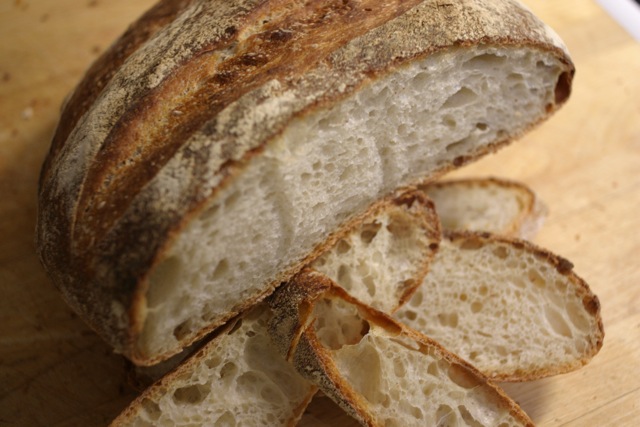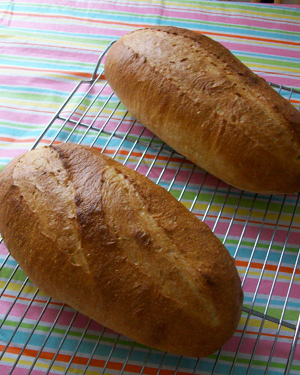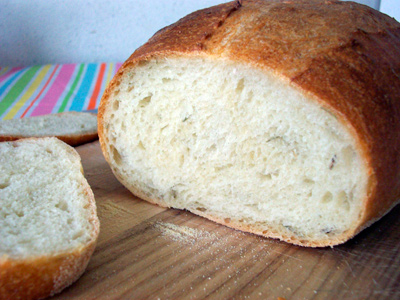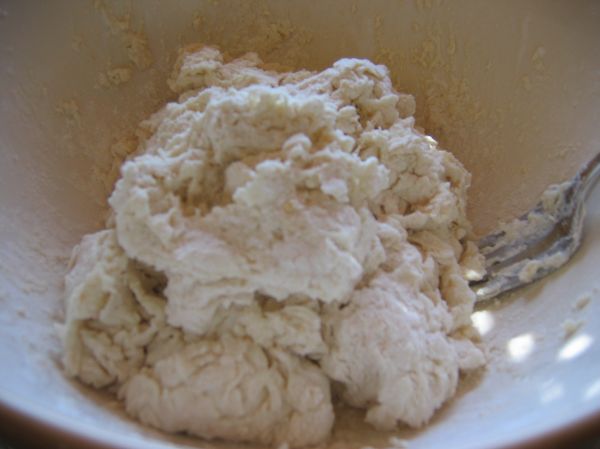
Sourdough Potato Bread
I baked Hamelman's Roasted Potato Bread a few months ago (http://www.thefreshloaf.com/node/10934/roasted-potato-bread-hamelman039s-quotbreadquot). Floyd commented that he had used leftover mashed potatoes to make bread. That sounded interesting. And I had admired the sourdough roasted potato bread about which SusanFNP had written in February of this year. See: http://www.wildyeastblog.com/2009/02/23/roasted-potato-bread-two-ways/.
So, today I made Sourdough Potato Bread with mashed potatoes left over from last night's dinner. (No seconds on potatoes for dmsnyder! <whine>)
Sourdough Potato Bread, shaped in the "Fendu" style.
Mashed potatoes
Boil 750 gms of yukon gold potatoes in their skins until a knife goes into them without resistance. Peel the potatoes and put them through a potato ricer. Mix with 1/3 cup of chopped shallots sautéed in 4 T good olive oil. Add salt (just a few dashes from a shaker) and fresh-ground pepper (12 twists of a mill) and mix thoroughly. Add more olive oil to taste. Reheat in a sauce pan over a low fire, turning frequently to minimize sticking. (I have also heated them in a covered enameled cast iron casserole in the oven.) Serve and enjoy, but set some aside to make bread the next day!
|
Ingredients |
|
|
Bread flour |
400 gms |
|
Whole wheat flour |
166 gms |
|
Water |
215 gms |
|
Salt |
12 gms |
|
Mashed potatoes with shallots |
157 gms |
|
Active levain (100% hydration) |
200 gms |
Procedures
-
In a large bowl, dissolve the levain in the water.
-
Add the mashed potatoes and mix. The potatoes can have some clumps, but they should be cherry-sized or smaller.
-
Add the two flours and mix to a shaggy mass.
-
Cover the bowl tightly and let the dough rest for 20-60 minutes to hydrate the flour and allow gluten to start developing.
-
After the autolyse, sprinkle the salt over the dough and mix it into the dough using the method of your choice. I used the “stretch and fold in the bowl” technique. See http://www.thefreshloaf.com/node/10682/mystery-page-249-solved”
-
Let the dough rest, covered, for 20 minutes, then repeat the “stretch and fold in the bowl.” Repeat the rest and stretch and fold twice more at 20 minute intervals.
-
Transfer the dough to a clean, lightly oiled glass container. (I use an 8 cup glass measuring pitcher.) Cover tightly.
-
Bulk ferment until double in volume. Stretch and fold on the counter at 50 and 100 minutes. Then allow fermentation to continue until the dough has doubled. (About another 50 minutes.)
-
Divide the dough into two equal pieces. Gently pre-shape into rounds. Cover with plasti-crap and allow to rest for 10-20 minutes to relax the gluten.
-
Shape the pieces into boules, batârds or, if you want to be traditional with the potato bread, into fendu shapes.
-
Proof the loaves in bannetons or en couche, covered with plastic to prevent drying of the surface. If you shaped fendus, proof with what will be the top of the loaf down. Allow the loaves to expand to 1.5 to 1.75 times their original volume.
-
About 45-60 minutes before baking, preheat the oven to 500F with a baking stone in place and prepared for your oven steaming method of choice. (I currently place a metal loaf pan and a cast iron skillet, heaping full of lava rocks, on the bottom rack of the oven. About 3 minutes before loading the loaves, I dump a handful of ice cubes into the loaf pan and shut the oven door. Just after loading the loaves in the oven, I pour ¾ to 1 cup of boiling water over the lava rocks and shut the oven door fast. I remove the containers 10-12 minutes into the bake. This process also “vents” the steam, so the loaves finish baking in a dry oven.)
-
Score the loaves as desired. (You don't score fendus, of course.) Load into the oven. Steam the oven immediately. Turn the oven down to 460F, and set a timer for 10 minutes.
-
After 10 minutes, remove your steaming hardware.
-
Turn down the oven to 440F. Continue baking until the loaves are done – internal temperature of 205F and the loaves give a hollow sound when thumped on the bottom. This should be about 20 minutes more. Monitor the loaves frequently for the last 20 minutes. The oil in the potatoes and, maybe, the sugar in the potatoes will cause the bread to brown more than a lean bread.
-
Cool the loaves completely before slicing.
Enjoy!
David
Submitted to YeastSpotting







 Combine the ingredients to make the preferment the night before baking. Leave them out at room temperature for roughly an hour and then refrigerate overnight.
Combine the ingredients to make the preferment the night before baking. Leave them out at room temperature for roughly an hour and then refrigerate overnight.







 Place in 350F preheated oven
Place in 350F preheated oven Apx. 35 min till done
Apx. 35 min till done Sliced Warm Crumb
Sliced Warm Crumb Soda Farls in the Iron Pan
Soda Farls in the Iron Pan Turned Over after about 10mins.
Turned Over after about 10mins. Place in towel to keep soft.
Place in towel to keep soft. Slice like this...
Slice like this... Farl Crumb
Farl Crumb Oh I'll just have an 1/8th...and another and another before I go on my bike ride!!
Oh I'll just have an 1/8th...and another and another before I go on my bike ride!!






